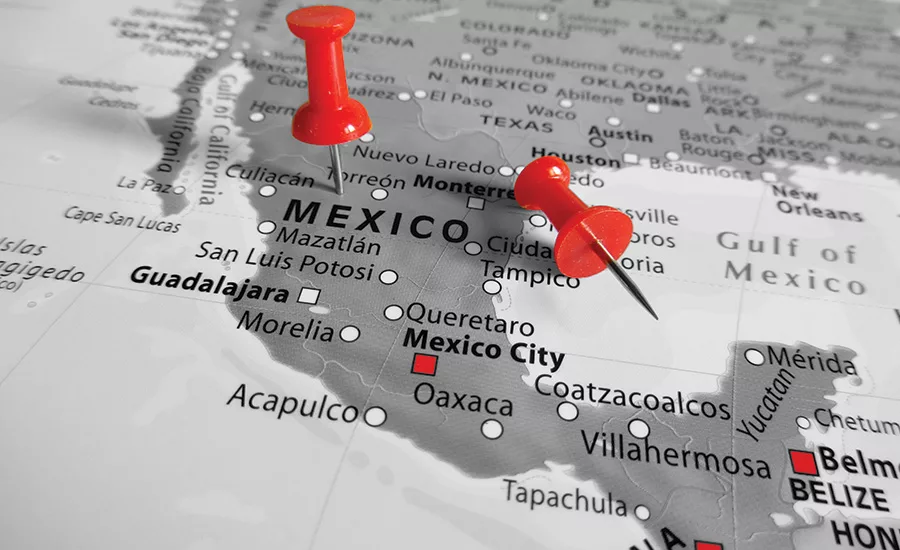Deteriorating Security Environment Threatens Business in Southwestern Mexico

Increased criminal activity has led to heightened insecurity throughout Mexico, especially in southwestern states. As a result, the economy lost nearly 13 percent of its GDP in 2015 from theft, extortion and other illicit activities; authorities lack a strategy to provide long-term stability.
Organized crime groups, commonly referred to as drug-trafficking organizations (DTOs), operate throughout Mexico and are the primary threat to business activity in the country. DTO operations have led to heightened insecurity across a majority of states, especially as groups diversify their illicit activities to include illegal mining and logging, reselling pirated goods, kidnapping and extortion. Over time, DTOs have also diversified drug production by increasing the production of heroin and methamphetamine, as demand for those drugs has surged in the U.S. while cocaine use has steadily decreased and U.S. states move to legalize the cultivation and consumption of marijuana. Methamphetamine and heroin are relatively easy to produce in Mexico and Central America, resulting in cheaper production costs when compared with importing cocaine or precursor products from South America. The most dangerous areas generally remain the Mexican states with infrastructure that facilitates access to U.S. illegal drug markets, the import of cocaine and precursor chemicals, and domestic production. Although billions of dollars have been spent to combat DTOs, the drug trade and its related criminal activities remain the primary drivers of violence, often prompting vicious turf battles between rival groups and forceful confrontations with police.
DTO-related crime in Mexico slightly worsened in the first quarter of 2016, according to official statistics from the Ministry of the Interior (SEGOB); the homicide rate increased by 11 percent compared with the same time period in 2015. The security situation in some southwestern Mexican states, especially Colima, Michoacán and Guerrero, has deteriorated significantly. High levels of violent crime continue in Guerrero, where criminal organizations have begun exerting extreme levels of force, including mass killings and forced disappearances. Chilpancingo, the capital of Guerrero, has often been the epicenter of the violence; dozens of bodies, showing signs of torture, have appeared in plazas and main thoroughfares in recent months. Colima, a state which has traditionally experienced low levels of DTO-related violence, has seen a 300-percent increase in homicides since early 2015, as well as a large uptick in assaults and armed robberies.
A recent report by the Institute for Economics and Peace showed that the Mexican economy lost approximately MXN 2.12 trillion ($134 billion) or 13 percent of its gross domestic product (GDP) in 2015 due to DTO activity and gang violence. DTO-related criminal activities represent a particularly acute threat to economic growth in southwestern Mexico. Hundreds of businesses have been forced to close or flee to more secure areas of the country due to violence, extortion and pervasive corruption in state and local governments and police forces. Acapulco, once a highly-popular resort town, has been particularly affected by increased DTO activity in the state. Businesspeople are killed on a near-daily basis for failure to pay extortion money, and police frequently engage DTOs in gun battles in the tourist zone. The cumulative effects of the violence have led to a large drop in revenue entering the local economy; many small shops, restaurants and tourist attractions have closed or moved their operations out of the city. As turf battles play out in southwestern Mexico over the coming months, more businesses will likely close, pushing the region deeper into poverty.
Trafficking of methamphetamines and heroin into the U.S., the engine that sustains DTO activity in Mexico, is anticipated to remain steady – or even increase – as many U.S. states face growing problems with drug addiction. The Mexican government recently hinted that it will soon seek to legalize the use of small amounts of marijuana in an effort to reduce DTOs’ revenue from drug-trafficking activities. However, many fear that DTOs will seek to replace revenue generated from marijuana cultivation by scaling up their income from other illicit activities such as extortion, kidnapping and hydrocarbon theft.
Although Guerrero has the highest levels of DTO-related crime in Mexico, Michoacán and Colima have experienced growing insecurity in recent months. The Cártel Jalisco Nueva Generación (CJNG), which is viewed as a rising and powerful DTO, has begun seizing territory and pushing out competing DTOs in Colima and Micho-acán states, resulting in violent turf wars. The Port of Manzanillo, which is one of the primary unloading points of precursors used to make methamphetamines, has been the scene of several mass-casualty shootouts. Although the Mexican Navy is present at the port, reports indicate that many of the terminals are at least partially controlled by CJNG or its rivals.
In 2012, self-defense groups began to form in Michoacán to combat DTOs such as the Knights Templar and remnants of the La Familia Michoacana. From 2012 through early 2015, Michoacán experienced a relative calm, due in part to the stability created by the self-defense groups; however, the government began to dismantle and criminalize the groups, arguing they were conducting illicit activities. This provided CJNG with the opportunity to increase its presence in Michoacán, which has recently led to clashes with Los Viagras and factions of the Knights Templar. In early April, a series of incidents involving police, self-defense groups and DTOs caused severe transport and supply-chain delays and interrupted commercial activity in southern Michoacán; several international companies suspended their activities in parts of the state due to the insecurity. Since the beginning of the year, the number of reported homicides increased, with a significant number of murders occurring in Morelia during January and February. The number of reported cases of extortion and kidnapping in Michoacán remained relatively steady between the fourth quarter of 2015 and the first quarter of 2016; however, due to underreporting, the actual number of cases is likely higher.
Although violence that could cause physical harm to employees or assets is not typically directed at enterprises uninvolved in criminal activity, trends in Mexico indicate that organized crime has the potential to substantially affect revenues. Considerable threats to revenue, mainly due to extortion and theft, exist in at least 21 of Mexico’s 31 states. The fragmentation of Mexico’s major DTOs suggests that the proliferation of groups relying on revenue from localized sources that can affect commercial income will remain a threat in the foreseeable future. Collateral damage associated with DTO conflicts does not normally affect multinational operations, but bystanders sometimes face indirect risks in areas experiencing escalating gang or DTO fighting. There is a heightened threat from these groups in rural towns and on remote stretches of highways.
Despite the severe consequences of DTO activity to business continuity and commerce, few practical solutions exist to combat the groups. DTOs continue to wield significant influence over local and state government officials and police departments. Many DTOs also have a stake in private enterprise, as illicit funds are frequently used to construct hotels and restaurants, or are laundered through front companies. The Mexican economy loses approximately 13 percent of GDP a year due to such crime; however, the figure in southwestern Mexico is likely higher. The federal government has sent military personnel to the region to quell highly disruptive flare ups of violence, but it lacks a strategy and the resources to provide long-term stability. DTO-related activities will likely continue to produce significant security threats that affect business operations and supply chains in the region. Although authorities will likely arrest or kill several high-ranking DTO leaders, turf wars, especially in Michoacán, will likely continue unabated until a dominant DTO emerges, as government action is not enough to suppress the organizations.
Looking for a reprint of this article?
From high-res PDFs to custom plaques, order your copy today!






